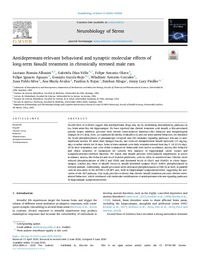Mostrar el registro sencillo de la publicación
Antidepressant-relevant behavioral and synaptic molecular effects of long-term fasudil treatment in chronically stressed male rats
| dc.contributor.author | Román-Albasini, Luciano | |
| dc.contributor.author | Díaz-Véliz, Gabriela | |
| dc.contributor.author | Olave, Felipe A. | |
| dc.contributor.author | Aguayo, Felipe | |
| dc.contributor.author | García-Rojo, Gonzalo | |
| dc.contributor.author | Corrales, Wladimir | |
| dc.contributor.author | Silva, Juan P. | |
| dc.contributor.author | Ávalos, Ana | |
| dc.contributor.author | Rojas, Paulina S. | |
| dc.contributor.author | Aliaga-Rojas, Esteban | |
| dc.contributor.author | Fiedler, Jenny L. | |
| dc.date.accessioned | 2021-11-23T12:55:59Z | |
| dc.date.available | 2021-11-23T12:55:59Z | |
| dc.date.issued | 2020 | |
| dc.identifier.uri | http://repositorio.ucm.cl/handle/ucm/3511 | |
| dc.description.abstract | Several lines of evidence suggest that antidepressant drugs may act by modulating neuroplasticity pathways in key brain areas like the hippocampus. We have reported that chronic treatment with fasudil, a Rho-associated protein kinase inhibitor, prevents both chronic stress-induced depressive-like behavior and morphological changes in CA1 area. Here, we examined the ability of fasudil to (i) prevent stress-altered behaviors, (ii) influence the levels/phosphorylation of glutamatergic receptors and (iii) modulate signaling pathways relevant to antidepressant actions. 89 adult male Sprague-Dawley rats received intraperitoneal fasudil injections (10 mg/kg/day) or saline vehicle for 18 days. Some of these animals were daily restraint-stressed from day 5–18 (2.5 h/day). 24 hr after treatments, rats were either evaluated for behavioral tests (active avoidance, anxiety-like behavior and object location) or euthanized for western blot analyses of hippocampal whole extract and synaptoneurosome-enriched fractions. We report that fasudil prevents stress-induced impairments in active avoidance, anxiety-like behavior and novel location preference, with no effect in unstressed rats. Chronic stress reduced phosphorylations of ERK-2 and CREB, and decreased levels of GluA1 and GluN2A in whole hippocampus, without any effect of fasudil. However, fasudil decreased synaptic GluA1 Ser831 phosphorylation in stressed animals. Additionally, fasudil prevented stress-decreased phosphorylation of GSK-3β at Ser9, in parallel with an activation of the mTORC1/4E-BP1 axis, both in hippocampal synaptoneurosomes, suggesting the activation of the AKT pathway. Our study provides evidence that chronic fasudil treatment prevents chronic stress-altered behaviors, which correlated with molecular modifications of antidepressant-relevant signaling pathways in hippocampal synaptoneurosomes. | es_CL |
| dc.language.iso | en | es_CL |
| dc.rights | Atribución-NoComercial-SinDerivadas 3.0 Chile | * |
| dc.rights.uri | http://creativecommons.org/licenses/by-nc-nd/3.0/cl/ | * |
| dc.source | Neurobiology of Stress, 13, 100234 | es_CL |
| dc.subject | Fasudil | es_CL |
| dc.subject | Chronic stress | es_CL |
| dc.subject | Behavior | es_CL |
| dc.subject | Hippocampus | es_CL |
| dc.subject | Synaptoneurosomes | es_CL |
| dc.subject | Antidepressants | es_CL |
| dc.title | Antidepressant-relevant behavioral and synaptic molecular effects of long-term fasudil treatment in chronically stressed male rats | es_CL |
| dc.type | Article | es_CL |
| dc.ucm.facultad | Facultad de Ciencias de la Salud | es_CL |
| dc.ucm.indexacion | Scopus | es_CL |
| dc.ucm.indexacion | Isi | es_CL |
| dc.ucm.doi | doi.org/10.1016/j.ynstr.2020.100234 | es_CL |



